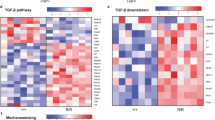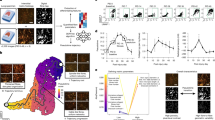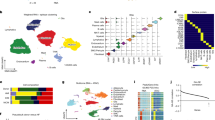Abstract
Fibulin-4 is a member of the fibulin family, a group of extracellular matrix proteins prominently expressed in medial layers of large veins and arteries. Involvement of the FBLN4 gene in cardiovascular pathology was shown in a murine model and in three patients affected with cutis laxa in association with systemic involvement. To elucidate the contribution of FBLN4 in human disease, we investigated two cohorts of patients. Direct sequencing of 17 patients with cutis laxa revealed no FBLN4 mutations. In a second group of 22 patients presenting with arterial tortuosity, stenosis and aneurysms, FBLN4 mutations were identified in three patients, two homozygous missense mutations (p.Glu126Lys and p.Ala397Thr) and compound heterozygosity for missense mutation p.Glu126Val and frameshift mutation c.577delC. Immunoblotting analysis showed a decreased amount of fibulin-4 protein in the fibroblast culture media of two patients, a finding sustained by diminished fibulin-4 in the extracellular matrix of the aortic wall on immunohistochemistry. pSmad2 and CTGF immunostaining of aortic and lung tissue revealed an increase in transforming growth factor (TGF)β signaling. This was confirmed by pSmad2 immunoblotting of fibroblast cultures. In conclusion, patients with recessive FBLN4 mutations are predominantly characterized by aortic aneurysms, arterial tortuosity and stenosis. This confirms the important role of fibulin-4 in vascular elastic fiber assembly. Furthermore, we provide the first evidence for the involvement of altered TGFβ signaling in the pathogenesis of FBLN4 mutations in humans.
Similar content being viewed by others
Log in or create a free account to read this content
Gain free access to this article, as well as selected content from this journal and more on nature.com
or
References
Argraves WS, Greene LM, Cooley MA, Gallagher WM : Fibulins: physiological and disease perspectives. EMBO Rep 2003; 4: 1127–1131.
Nakamura T, Lozano PR, Ikeda Y et al: Fibulin-5/DANCE is essential for elastogenesis in vivo. Nature 2002; 415: 171–175.
Sasaki T, Gohring W, Miosge N, Abrams WR, Rosenbloom J, Timpl R : Tropoelastin binding to fibulins, nidogen-2 and other extracellular matrix proteins. FEBS Lett 1999; 460: 280–284.
Yanagisawa H, Davis EC, Starcher BC et al: Fibulin-5 is an elastin-binding protein essential for elastic fibre development in vivo. Nature 2002; 415: 168–171.
Giltay R, Timpl R, Kostka G : Sequence, recombinant expression and tissue localization of two novel extracellular matrix proteins, fibulin-3 and fibulin-4. Matrix Biol 1999; 18: 469–480.
Hanada K, Vermeij M, Garinis GA et al: Perturbations of vascular homeostasis and aortic valve abnormalities in fibulin-4 deficient mice. Circ Res 2007; 100: 738–746.
McLaughlin PJ, Chen Q, Horiguchi M et al: Targeted disruption of fibulin-4 abolishes elastogenesis and causes perinatal lethality in mice. Mol Cell Biol 2006; 26: 1700–1709.
Coucke PJ, Willaert A, Wessels MW et al: Mutations in the facilitative glucose transporter GLUT10 alter angiogenesis and cause arterial tortuosity syndrome. Nat Genet 2006; 38: 452–457.
Loeys BL, Schwarze U, Holm T et al: Aneurysm syndromes caused by mutations in the TGF-beta receptor. N Engl J Med 2006; 355: 788–798.
Neptune ER, Frischmeyer PA, Arking DE et al: Dysregulation of TGF-beta activation contributes to pathogenesis in Marfan syndrome. Nat Genet 2003; 33: 407–411.
Huang J, Davis EC, Chapman SL et al: Fibulin-4 deficiency results in ascending aortic aneurysms. a potential link between abnormal smooth muscle cell phenotype and aneurysm progression. Circ Res 2010; 106: 583–592.
Dasouki M, Markova D, Garola R et al: Compound heterozygous mutations in fibulin-4 causing neonatal lethal pulmonary artery occlusion, aortic aneurysm, arachnodactyly, and mild cutis laxa. Am J Med Genet A 2007; 143: 2635–2641.
Hucthagowder V, Sausgruber N, Kim KH, Angle B, Marmorstein LY, Urban Z : Fibulin-4: a novel gene for an autosomal recessive cutis laxa syndrome. Am J Hum Genet 2006; 78: 1075–1080.
Hoyer J, Kraus C, Hammersen G, Geppert JP, Rauch A : Lethal cutis laxa with contractural arachnodactyly, overgrowth and soft tissue bleeding due to a novel homozygous fibulin-4 gene mutation. Clin Genet 2009; 76: 276–281.
Claus S, Fischer J, Megarbane H et al: A p.C217R mutation in fibulin-5 from cutis laxa patients is associated with incomplete extracellular matrix formation in a skin equivalent model. J Invest Dermatol 2008; 128: 1442–1450.
Elahi E, Kalhor R, Banihosseini SS et al: Homozygous missense mutation in fibulin-5 in an Iranian autosomal recessive cutis laxa pedigree and associated haplotype. J Invest Dermatol 2006; 126: 1506–1509.
Loeys B, Van Maldergem L, Mortier G et al: Homozygosity for a missense mutation in fibulin-5 (FBLN5) results in a severe form of cutis laxa. Hum Mol Genet 2002; 11: 2113–2118.
Markova D, Zou Y, Ringpfeil F et al: Genetic heterogeneity of cutis laxa: a heterozygous tandem duplication within the fibulin-5 (FBLN5) gene. Am J Hum Genet 2003; 72: 998–1004.
Kornak U, Reynders E, Dimopoulou A et al: Impaired glycosylation and cutis laxa caused by mutations in the vesicular H+-ATPase subunit ATP6V0A2. Nat Genet 2008; 40: 32–34.
Kivuva EC, Parker MJ, Cohen MC, Wagner BE, Sobey G : De Barsy syndrome: a review of the phenotype. Clin Dysmorphol 2008; 17: 99–107.
Morava E, Guillard M, Lefeber DJ, Wevers RA : Autosomal recessive cutis laxa syndrome revisited. Eur J Hum Genet 2009; 17: 1099–1110.
Guernsey DL, Jiang H, Evans SC et al: Mutation in pyrroline-5-carboxylate reductase 1 gene in families with cutis laxa type 2. Am J Hum Genet 2009; 85: 120–129.
Reversade B, Escande-Beillard N, Dimopoulou A et al: Mutations in PYCR1 cause cutis laxa with progeroid features. Nat Genet 2009; 41: 1016–1021.
Rodriguez-Revenga L, Iranzo P, Badenas C, Puig S, Carrio A, Mila M : A novel elastin gene mutation resulting in an autosomal dominant form of cutis laxa. Arch Dermatol 2004; 140: 1135–1139.
Szabo Z, Crepeau MW, Mitchell AL et al: Aortic aneurysmal disease and cutis laxa caused by defects in the elastin gene. J Med Genet 2006; 43: 255–258.
Tassabehji M, Metcalfe K, Hurst J et al: An elastin gene mutation producing abnormal tropoelastin and abnormal elastic fibres in a patient with autosomal dominant cutis laxa. Hum Mol Genet 1998; 7: 1021–1028.
Zhang MC, He L, Giro M, Yong SL, Tiller GE, Davidson JM : Cutis laxa arising from frameshift mutations in exon 30 of the elastin gene (ELN). J Biol Chem 1999; 274: 981–986.
Ades LC, Knight WB, Byard RW et al: Clinicopathologic findings in congenital aneurysms of the great vessels. Am J Med Genet 1996; 66: 289–299.
Baspinar O, Kilinc M, Balat A, Celkan MA, Coskun Y : Long tortuous aorta in a child with Larsen syndrome. Can J Cardiol 2005; 21: 299–301.
Kobayashi N, Kostka G, Garbe JH et al: A comparative analysis of the fibulin protein family. Biochemical characterization, binding interactions, and tissue localization. J Biol Chem 2007; 282: 11805–11816.
Loeys BL, Chen J, Neptune ER et al: A syndrome of altered cardiovascular, craniofacial, neurocognitive and skeletal development caused by mutations in TGFBR1 or TGFBR2. Nat Genet 2005; 37: 275–281.
Callewaert BL, Willaert A, Kerstjens-Frederikse WS et al: Arterial tortuosity syndrome: clinical and molecular findings in 12 newly identified families. Hum Mutat 2008; 29: 150–158.
Rao Z, Handford P, Mayhew M, Knott V, Brownlee GG, Stuart D : The structure of a Ca(2+)-binding epidermal growth factor-like domain: its role in protein-protein interactions. Cell 1995; 82: 131–141.
Hu Q, Reymond JL, Pinel N, Zabot MT, Urban Z : Inflammatory destruction of elastic fibers in acquired cutis laxa is associated with missense alleles in the elastin and fibulin-5 genes. J Invest Dermatol 2006; 126: 283–290.
Freeman LJ, Lomas A, Hodson N et al: Fibulin-5 interacts with fibrillin-1 molecules and microfibrils. Biochem J 2005; 388: 1–5.
Ono RN, Sengle G, Charbonneau NL et al: LTBPS and fibulins compete for fibrillin-1 and exhibit exquisite specificities in binding sites. J Biol Chem 2009; 284: 16872–16881.
Ng CM, Cheng A, Myers LA et al: TGF-beta-dependent pathogenesis of mitral valve prolapse in a mouse model of Marfan syndrome. J Clin Invest 2004; 114: 1586–1592.
Habashi JP, Judge DP, Holm TM et al: Losartan, an AT1 antagonist, prevents aortic aneurysm in a mouse model of Marfan syndrome. Science 2006; 312: 117–121.
Acknowledgements
We are indebted to P Willems for providing skin fibroblasts of FBLN4 mutation-positive patients, to D Zwick and A Kats for providing sections of aorta and lung tissue of patient 5 and to L Myers for the optimized pSmad2 immunohistochemical protocol. We are very grateful to N Charbonneau for generating the antibodies to fibulin-4, T Sasaki for recombinant human fibulin-4 and the National Marfan Foundation for providing funding to generate fibulin-4 monoclonal antibodies. We thank K Wettinck for excellent technical assistance with the molecular analyses. B Loeys and M Renard are, respectively, senior clinical investigator and junior scientific investigator supported by the Fund for Scientific Research, Flanders (Belgium). This work was supported by the Fund for Scientific Research, Flanders (Belgium) (G.0094.06); Fighting Aneurysmal Disease (EC-FP7); and Methusalem (08/01M01108 to ADP).
Author information
Authors and Affiliations
Corresponding author
Ethics declarations
Competing interests
The authors declare no conflict of interest.
Additional information
Supplementary Information accompanies the paper on European Journal of Human Genetics website ()
Rights and permissions
About this article
Cite this article
Renard, M., Holm, T., Veith, R. et al. Altered TGFβ signaling and cardiovascular manifestations in patients with autosomal recessive cutis laxa type I caused by fibulin-4 deficiency. Eur J Hum Genet 18, 895–901 (2010). https://doi.org/10.1038/ejhg.2010.45
Received:
Revised:
Accepted:
Published:
Issue date:
DOI: https://doi.org/10.1038/ejhg.2010.45
Keywords
This article is cited by
-
Absence of LTBP-3 attenuates the aneurysmal phenotype but not spinal effects on the aorta in Marfan syndrome
Biomechanics and Modeling in Mechanobiology (2019)
-
Inflammation in thoracic aortic aneurysms
Herz (2019)



